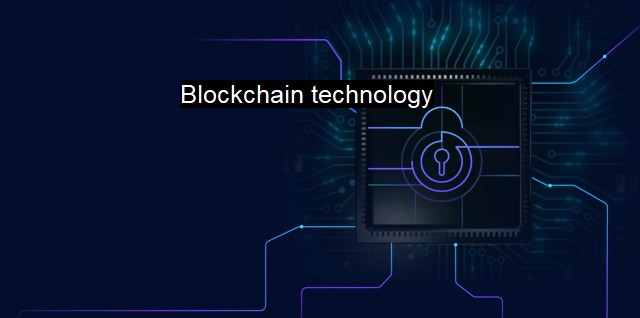What is Blockchain technology?
The Role of Blockchain Technology in Strengthening Cybersecurity: A Closer Look into Its Features and Properties
Blockchain technology has risen to prominence from the fame of cryptocurrencies, especially Bitcoin. its applications are expanding in various sectors of technology, one of them being cybersecurity. Technological advancements continue to revolutionize antivirus measures, and one of the rising prospects is the employment of blockchain technology in antivirus and cybersecurity efforts.Blockchain technology is a disruptive innovation that secures transactions with the potency to reshuffle business operations across many industries. As the name suggests, blockchain is a chain of blocks where a block represents digital information, and the chain is the public database. The information/data is stored in these blocks, which are linked to each other, thus forming the chain for the blockchain technology.
Each block typically comprises digital pieces of information, including timestamps of transactions or current and previous states of a file or document. The primary underpinning of the blockchain network is that it is decentralized, meaning no single governing body owns or controls it. Instead, each node or computer in the blockchain network owns a copy of the entire blockchain, and all these blocks are connected systematically. Therefore, if a person makes any change in one block, all the nodes within the network will know it, ensuring utmost transparency.
The significance of blockchain in cybersecurity and antivirus measures emanates from its unique features of redundancy, immutability, and transparency. These impede unauthorized access and alterations, enhancing the security measures.
Distributed technology provides a higher degree of security for sensitive information as it's spread over countless computers contributing to the network. Cybercriminals would have to control over half of these machines to overrule the system. This aspect of blockchain confers resistance to threats, including malware and hackers.
Blockchains contain highly traceable record-keeping benefit valuable against cyber threats. Transactions are first hashed, a process that turns them into a string of characters no matter how large the initial data. It becomes part of the block, secured by appending it to the chain. The layered security offers distribution of data, close to impossible to be changed once secured. Immutable blocks can help users verify if a particular file has changed drastically over time, becoming the source of malware.
Transparency fosters tracking transactions with complete details throughout the lifecycle, significantly enhancing integrity and accountability in data management. This also magnifies earning trust amongst the participants involved in the blockchain.
As the threats to cyberspace increase with the evolving technology and internet outreach, the conventionally centralized security systems seem to pose limitations, delivering fewer capacities for managing digital threats. This is where blockchain shines, in overcoming these limitations through its identity management feature allowing every user to encrypt their data and control the data's decryption keys. As a result, the movement of the data source would be under the proper surveillance of the individual blockchain user. More so, it mitigates password-related threats as it abolishes the need for passwords in the first place.
The applications of blockchain technology are only limited by our ability to think and innovate. Blockchain is demonstrating to diffuse into here-to-fore areas and subjects that seem non-contextual to cryptocurrency technology. Cybersecurity and antivirus are amongst such applications. Organizations are evolving and unlocking blockchain's potential in charting newer cyber risk management avenues. embracing blockchain could dramatically improve capabilities to respond to cyber threats and lay secure foundations for the digital age's cybersecurity. But it has significant distance to cover, like inspiring trust in its usage, compatibility issues, before it gets extensively incorporated into the cybersecurity world.

Blockchain technology FAQs
What is blockchain technology and how does it relate to cybersecurity?
Blockchain technology is a decentralized digital ledger system that records transactions between two parties in a secure and transparent manner. It has applications in cybersecurity as it provides a high level of data protection by enabling secure data sharing and storage across a network of computers.How is blockchain technology used in antivirus software?
Blockchain technology is used in antivirus software to create a distributed database of file signatures that can detect malware in real-time. This blockchain database is constantly updated and shared across the network, preventing hackers from creating new variants of malware that may go undetected by traditional antivirus software.What are the benefits of using blockchain technology in cybersecurity?
The benefits of using blockchain technology in cybersecurity include enhanced security and transparency, reduced fraud, improved data sharing, and increased efficiency. It provides secure data storage and sharing across a network of computers, without the need for central authorities or intermediaries, making it resistant to cyberattacks.What are some of the challenges faced with the implementation of blockchain technology in cybersecurity?
Some of the challenges faced with the implementation of blockchain technology in cybersecurity include scalability issues, interoperability, and regulatory uncertainty. Blockchain technology is still in its early stages, and there are technical and regulatory challenges that need to be addressed before it can be fully adopted in cybersecurity.| | A | | | B | | | C | | | D | | | E | | | F | | | G | | | H | | | I | | | J | | | K | | | L | | | M | |
| | N | | | O | | | P | | | Q | | | R | | | S | | | T | | | U | | | V | | | W | | | X | | | Y | | | Z | |
| | 1 | | | 2 | | | 3 | | | 4 | | | 7 | | | 8 | | |||||||